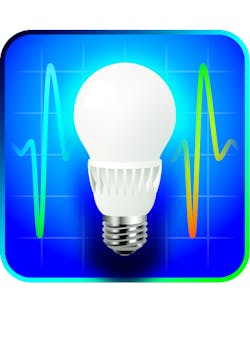Now the LRC calls blue a ‘significant’ melatonin suppressor
If this were an NFL game, it might go something like this: “Upon further review, spectra is indeed a big contributor.” Although the LRC tells LEDs that amount is still far more important.
Wait a minute. Maybe the blue spectrum is as guilty of disturbing sleep as was generally believed after all.
Two weeks after we reported on a controversial new study by the Lighting Research Center (LRC) which observed “no significant main effect of spectrum” in suppressing the sleep hormone melatonin, we uncovered a contemporaneous study by the same group that spotted “significant main effects” of spectrum.
In our story last month, we noted that the LRC study published in the Journal of Biological Rhythms concluded that the amount of light — duration plus intensity — far outweighs the impact of blue wavelengths when it comes to suppressing melatonin.
In that study, the LRC specifically looked at the effect of removing blue spectra by lowering the energy output of specific blue/cyan wavelengths between 475 and 495 nm — light known as “cyan gap.”
“There was no significant main effect of spectrum,” the LRC stated in that report, titled “Effect of White Light Devoid of “Cyan” Spectrum Radiation on Nighttime Melatonin Suppression Over a 1-h Exposure Duration.”
“There were no significant interactions with spectrum,” the researchers concluded.
It was a contentious observation, because it seemed to clash with a series of findings over the years from other circadian lighting experts emphasizing that blue does indeed mess with melatonin.
Such was the reaction to our story that circadian scientists outside of LRC drew our attention to a second LRC study — in the same April edition of the same Journal of Biological Rhythms,of all places — which delivers a notably different conclusion.
In the abstract to the second study, titled “Nocturnal Melatonin Suppression by Adolescents and Adults for Different Levels, Spectra, and Durations of Light Exposure,”the LRC stated, “The study’s primary goal was to measure nocturnal melatonin suppression for a wide range of light levels (40 to 1000 lux), 2 white light spectra (2700 K and 6500 K), and an extended range of nighttime light exposure durations (0.5 to 3.0 h).” It looked at light's impact on 41 individuals — 23 adults and 18 adolescents.
What did it find?
“Results showed significant main effects of light level, spectrum, and exposure duration on melatonin suppression,” the second LRC abstract noted.
In analyzing the results, the authors also pointed out that light with a bluish color temperature of 6500K quashed more melatonin than did 2700K light associated with warmer colors.
“The mean melatonin suppression was greater for the 6500 K source...compared with the 2700 K source,” the authors stated.
As with the previously reported Cyan Gap study, the LRC also gave duration a bad rap in the new study (“bad” is our word; bad, that is, if sleep is desired, although on other occasions melatonin suppression may deliver positive effects). “The analysis also revealed a significant main effect of exposure duration, indicating that longer exposure durations suppressed melatonin to a greater degree during participants’ biological night,” the study noted.
But unlike in the Cyan Gap study, the Nocturnal Melatonin Suppression study seems to draw no outward distinction between the relative impact of the two, and, to our reading, implied a certain equality.
We asked the LRC whether the two studies contradict each other.
“No,” a spokesperson replied.
Referring to the Nocturnal Melatonin Suppression study, she noted, “The effect of light level and exposure duration on melatonin suppression was much larger compared to the effect of spectrum. Thus, the results of both studies are aligned, showing that light level and duration matter more than spectrum for commonly used ‘white’ light sources. It is well established that cool and/or blue light is more effective for suppressing melatonin than warm light. So, yes, spectrum does matter. However, varying dose (light level × duration) has much more impact on melatonin suppression than varying the spectral composition of the light source.”
Watch for more coverage in LEDs on what is shaping up as a clash of scientific findings.
The Cyan Gap study ran online in the journal on Mar. 1, 2019. Nocturnal Melatonin Suppressionran online on Feb. 25 (LEDs Magazine discovered them in reverse order). They ran together in the April print edition.
The LRC authors were the same for both studies, listed as Rohan Nagare, Mark S. Rea, Barbara Plitnick, and LRC director Mariana G. Figueiro. LRC is part of Rensselaer Polytechnic Institute in Troy, NY.
MARK HALPER is a contributing editor for LEDs Magazine, and an energy, technology, and business journalist ([email protected]).

Mark Halper | Contributing Editor, LEDs Magazine, and Business/Energy/Technology Journalist
Mark Halper is a freelance business, technology, and science journalist who covers everything from media moguls to subatomic particles. Halper has written from locations around the world for TIME Magazine, Fortune, Forbes, the New York Times, the Financial Times, the Guardian, CBS, Wired, and many others. A US citizen living in Britain, he cut his journalism teeth cutting and pasting copy for an English-language daily newspaper in Mexico City. Halper has a BA in history from Cornell University.





